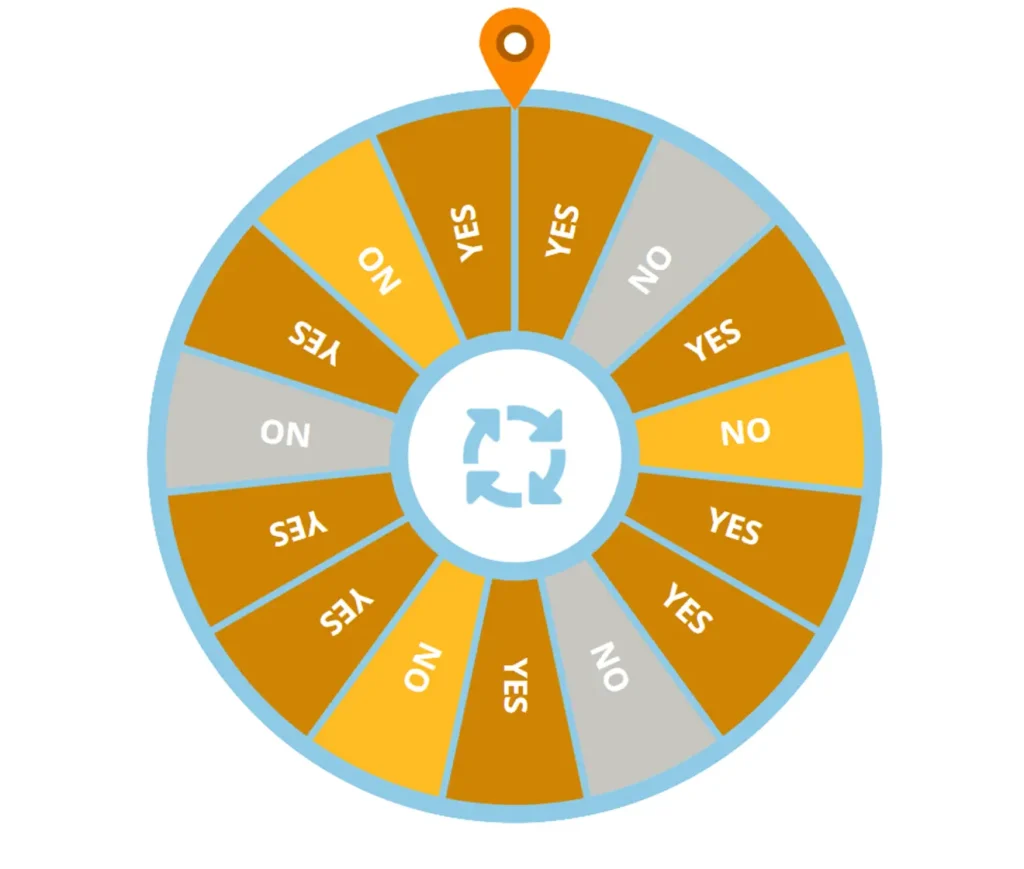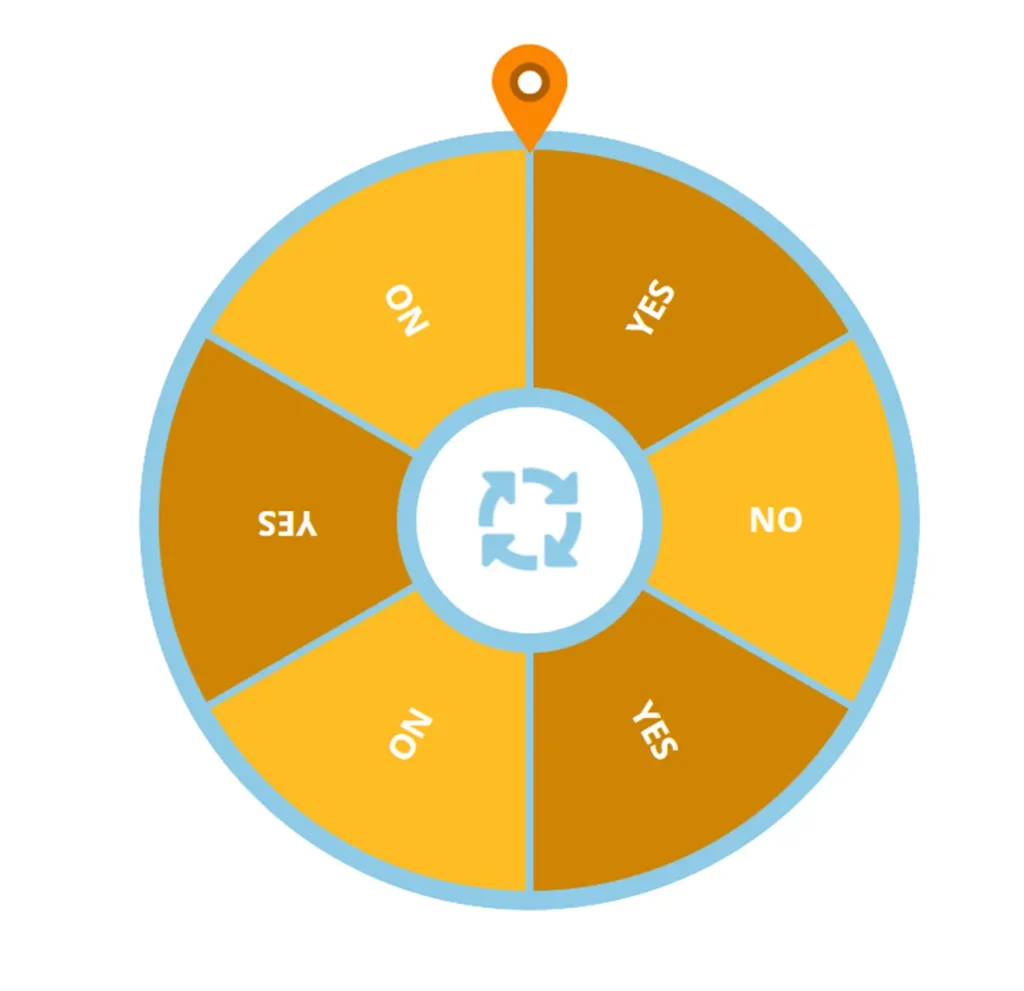Make Decisions Easy by Using wheel With a Yes or No Flip in 2025
Items to Show
If you’re looking for random yes or no answers to your intuition to make decisions easy, you’ve come to the right place. Let’s dive into what makes the Yes or No Flip so captivating and how you can use it to add a dash of excitement to your day.
Life is full of choices, big and small. From the everyday (should I have cereal or toast?) to the momentous (should I take this new job?), making these decisions can be daunting. Sometimes, we crave a little more direction, a way to inject some chance into the equation. That’s where the Yes or No Flip comes in.
This simple tool, rooted in the tradition of coin flips gives a randomized approach to decision-making. Limiting the answer to yes or no forces you to confront the core of your dilemma and potentially unveils a hidden preference.
If you’re looking for random yes or no answers to your intuition to make decisions easy, you’ve come to the right place. Here you’ll find online spin tools like a Yes or No Wheel, Yes or No Generator, Picker Wheel, Yes or No Spinner, and many more.
Let’s dive into what makes the Yes or No Flip so captivating and how you can use it to add a dash of excitement to your day.
Table of Contents
What is Yes or No Flip?
Just like a coin toss, a Yes or No Flip is a simple way to get a random answer to a yes-or-no question. It can be a physical act, like flipping a coin or a special Yes or No Wheel (found online or in some novelty stores). It may surprise you that a coin flipper is actually more random than flipping a coin in actuality.
With a simple coin, there are more chances of heads or tails depending on how it’s created. The reason is it slightly makes the coin weigh more on one side than other. It creates biased results.
More commonly these days, it’s done virtually using random result generators found on websites. With a simple click of a mouse, you can get random heads or tails results for free. It may sound like a whimsical approach, but the game has a way of cutting through puzzles by giving clarity to your intuition.
More commonly these days, it’s done virtually using random result generators found on websites. With a simple click of a mouse, you can get random heads or tails results for free. It may sound like a whimsical approach, but the game has a way of cutting through puzzles by giving clarity to your intuition.
So, what are you waiting for? This is a Yes or No flip using an online coin to get random unbiased results. Whenever feel indecision, flip the coin, and let fate decide.
Yes or No Coin Flip History
The history of the Yes or No Coin Flip game traces back to ancient times when the act of flipping a coin for decision-making was a common practice. The origins can be found in the ancient Roman tradition of “navia aut caput,” meaning “ship or head.”
In this game, a person would hold a coin and call out “ship” (Navia) for the ship side of the coin or “head” (Caput) for the head side. The outcome of the coin flip was believed to be influenced by the gods, guiding in matters of uncertainty.
This practice of using a coin for decisions evolved over centuries, becoming a widely recognized method of resolving dilemmas in various cultures. To make serious decisions related to property, criminality, and marriage, the Yes or No Flips were used. The final result was considered legally binding.
Later in history, the same game was marked as “cross and pile” in British. The word pile is a Middle English term that means “reverse of a coin”. At that time, many coins were named “cross” on one side and “pile” on the other.
In Ancient China, the same game was famous as “ship or head.” The reason is ancient Chinese coins were minted with a ship on one side and a head on the other.
Although the true origin of the coin toss is a subject of ongoing debate, historians commonly trace it back to Ancient Greece. It may have been seen that both sides of the shell were covered with a specific substance called “black pitch” – a pine wrap (less black but very dark brown) which may derive from the resin trees secrete.
Another side of the shell will remain the same original color. Then players would toss shells and one would shout the right side which is the same as we do now!
In more recent history, the term “flipping a coin” gained popularity, especially in the 19th and 20th centuries. It became a symbol of impartiality and a simple way to make decisions without bias.
The concept of assigning “Yes” to one side of the coin and “No” to the other likely emerged as a natural progression to get a binary outcome of choices. Today, the Yes or No Flip way continues to be a beloved and effective tool for decision-making, blending ancient traditions with modern simplicity to offer a playful and insightful approach to cater to life’s uncertainties.

How to Play?
Flipping a coin is easier than flipping a pancake. You just have to click the button. If you want to put some muscle, hold the coin and then release it to activate the energy. For better-unbiased results, follow these steps:
- Define Your Options: Start by clearly outlining the two choices in your mind. For example, it could be deciding between two restaurants for dinner, choosing which movie to watch, or even making a career-related decision.
- Assign Yes and No: Once you have your options, assign “Yes” to one choice and “No” to the other. This step is crucial, as it determines the outcome of the flip.
- Flip the Coin: Whether you’re using a physical coin or a digital tool, flip the coin and let it land. If it’s heads, it’s a “Yes.” If it’s tails, it’s a “No.”
- Reflect on Your Reaction: Here’s where the magic happens. Pay attention to your immediate reaction to the outcome. Are you relieved, disappointed, or surprised? This will reflect your inner preference and what you want.
NOTE: Every flip in this Yes or No Flip is 50:50 for head and tail shots. This is a tool like a real flip Coin. The fun part is here you can see clear results and stats on the screen.
Why Use Yes or No Flip?
1. Free and Easy to Use
You don’t need to download any app or pay the registration fee. Simply come on thechoicewheel.com from any device and click the coin for free use.
2. Breaks Analysis Paralysis
We’ve all been there – debating between two options with no clear winner. Yes or No Flip gives a quick way to break free from analysis paralysis and make a decision. It helps nudge you in a direction and stay away from overthinking.
3. Taps into Intuition
Often, our gut feelings guide us toward the right choice. By observing your reaction to the coin flip, you might uncover your true desires.
4. Instant Results
With a simple flip of the coin, you get an immediate answer to your dilemma. This quick turnaround is perfect for those who want to make decisions efficiently. The perk does not stay here, assigning “Yes” to one option and “No” to the other but the Yes or No Generator provides a clear, binary outcome to your decision-making process.
5. Adds a Fun Element
Let’s be honest, making decisions sometimes feels like a chore. Yes or No Flip injects a sense of playfulness into the process, making it more enjoyable. You feel making decisions is a playful adventure rather than a daunting task.
6. Unbiased Outcomes
With a random coin flip, there are two possibilities: heads or tails. You can estimate either 50:50 chances for each one or there is an exception. Nothing can prevent heads from coming up every tie in a row. The previous coin flip does not affect the net one, so you have equal chances of coming up either heads or tails, no matter how many times you flip the digital coin.
7. Customization Options
Want to add ice to the cake? You can make changes to the coin to make it truly yours. You can change the color, sound, and count numbers just by clicking the “Setting” button. The changes you made will be saved in your browser storage.
8. Suitable for Solo Play
When playing with others, you may end up with a mess. That’s why some prefer to play alone. For them, this coin flip offers a playful and light-hearted way to approach decision-making, adding an element of fun to the process.
9. Promote Acceptance
Acceptance of happenings is the first step toward overcoming the challenges. Sometimes, the outcome of the flip might surprise you. Accepting the result, even if it’s not what you initially wanted, fosters acceptance and adaptability. When you adapt yourself according to the situation, it simply makes you strong enough to face reality.
10. Digital Options Available
If you are a smartphone user and worry about whether a digital Yes or No flip coin can work on your phone, be calm down. Some numerous apps and websites offer this digital coin flipping for those who prefer a tech-savvy approach. You can browse through your phone, Mac, or Windows devices.
11. Subconscious Preference
The act of flipping can sometimes reveal your subconscious desires. For instance, a feeling of relief or disappointment with the outcome might highlight your true preferences.
12. Randomness
The coin flip relies on a randomizing mechanism to deliver unpredictable outcomes. The chance of a random choice helps to eliminate indecision and promote quick decision-making.
13. Visual Appeal
The spinning coin is often designed with visually appealing graphics or animations to enhance user experience and encourage repeated use. The colorful segments attract users for spinning.
14. Stress-Free Decision Maker
Sometimes, thinking about making simple choices feels dumb and stressful. When 24/7 you have a burden on your shoulders, it becomes hard to pay attention to important life choices. Here comes this tool to get a yes or no answer without any stress.
15. Encourage Spontaneity
Flipping a coin can encourage spontaneity and add an element of surprise to your life. It can help you step outside of your comfort zone and try new things. The con flip push you toward the choices that you have never consdered before.

When to Use Yes or No Flip?
- Can’t decide what to have for lunch? Let the coin decide!
- From date night ideas to vacation destinations, use the Custom Wheel Spinner to make joint decisions.
- When weighing job offers or considering career changes, flipping coin give a fresh perspective.
- Artists, writers, and designers turn to Yes or No Flip for inspiration on project directions.
- While playing with friends, flip the coin to decide the player’s turn.
- Can’t decide between pizza or pasta? Flip for a fun way to choose.
- Deadlocked on who washes the dishes? Let the flip decide!
- To resolve the dispute between two players, assign one head and the other tail.
- Flip the coin to teach children and students the nature of probability.
- To make a pick in fantasy leagues, flip the coin.
- To settle family arguments, a random coin flip can help out without getting into further discussion.
- Puzzled between choosing whether to do something or not, turn to Yes or No Flip.
Questions to Ask From Yes or No Flip
A Yes or No Flip is a great way to make quick decisions or add some fun to your day. Here are some questions you can ask:
- Am I going to have a great day today?
- Will I meet someone new today?
- Should I take a risk today?
- Will I get good news this week?
- Is it time for a change in my life?
- Will my favorite team win their next game?
- Will I eat pizza tonight?
- Will my phone battery die before the end of the day?
- Should I order dessert?
- Is now a good time for a workout?
- Should I read a book this evening?
- Is it worth staying up late tonight?
- Should I try cooking a new recipe?
- Is today a good day for a spontaneous trip?
- Should I spend some time on self-care today?
And the list goes on and on!
Tips for a Fulfilling Experience
- Trust the Process: Once you flip the coin, honor the result. This helps in embracing the spontaneity of the game.
- Reflect Afterwards: Take a moment to reflect on why the outcome resonated with you or why it didn’t. This self-awareness can be enlightening.
- Have Fun with It: Whether you’re playing solo or with others, approach Yes or No Flip with a sense of light-heartedness.
- Use it Sparingly: Reserve the Yes or No Flip for lighthearted or less critical decisions.
- Stay Open-Minded: Embrace the randomness and be open to new possibilities and experiences.
- Combine with Intuition: Use the flip as a guide but also listen to your gut feelings.
Yes or No Flip Coin Psychology
Coin Flip truly affects human behavior and decision-making when faced with the outcome of a simple flip. A branch of psychology explores how individuals react to the “Yes” or “No” result of the flip.
One aspect often studied is the concept of “revealed preference,” where the immediate emotional response to the coin flip outcome reveals underlying desires or preferences that might not have been consciously acknowledged.
Psychologists observe whether individuals feel relief, disappointment, or indifference to the result, providing clues to their true feelings about the options at hand.
Whenever you feel a struggle to make a decision, flip a coin. When you see the results “Look into your reactions. Ask yourself: Am I pleased? Am I disappointed?” This method of flipping is sometimes called the Freudian Coin Toss. By analyzing your reaction, you may realize that you knew the choice that you wanted to make all along!
Wrap-up
Yes or No Flip might seem like a simple game, but its power lies in its ability to offer clarity, tap into intuition, and add a touch of fun to decision-making. Whether you’re facing a minor choice or a major crossroads, this game invites you to accept spontaneity and explore new possibilities.
Remember, the flip is a guide, not a dictator. Use it wisely, and trust your gut when necessary. So, the next time you’re unsure of what path to take, give the coin a flip and let fate guide you on a playful adventure of decision-making!
After all, as the coin lands, a world of “Yes” or “No” awaits.
